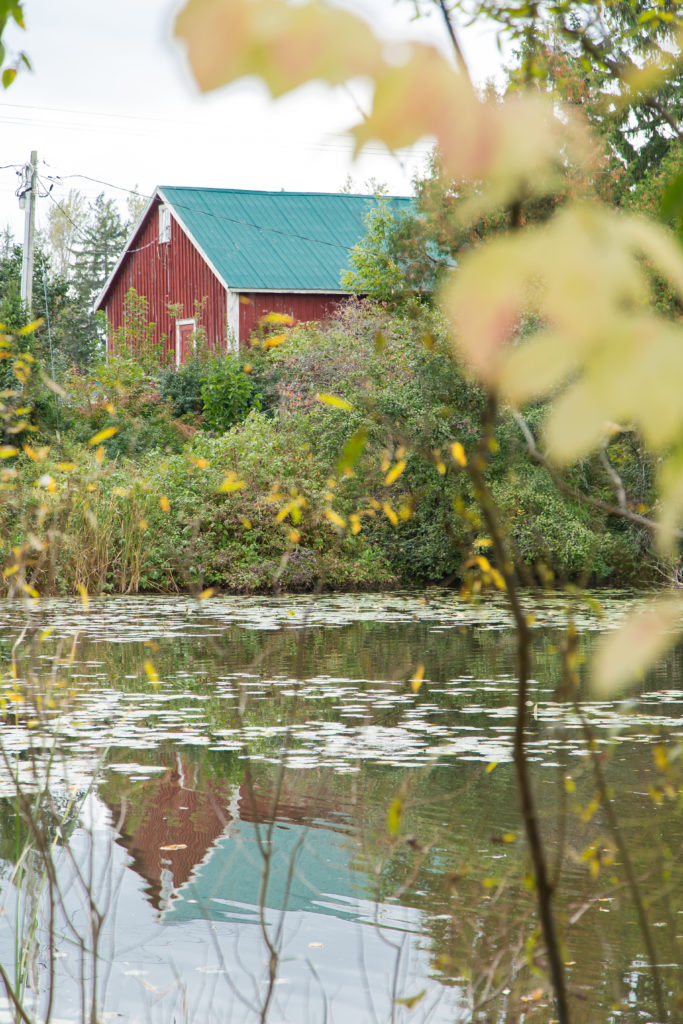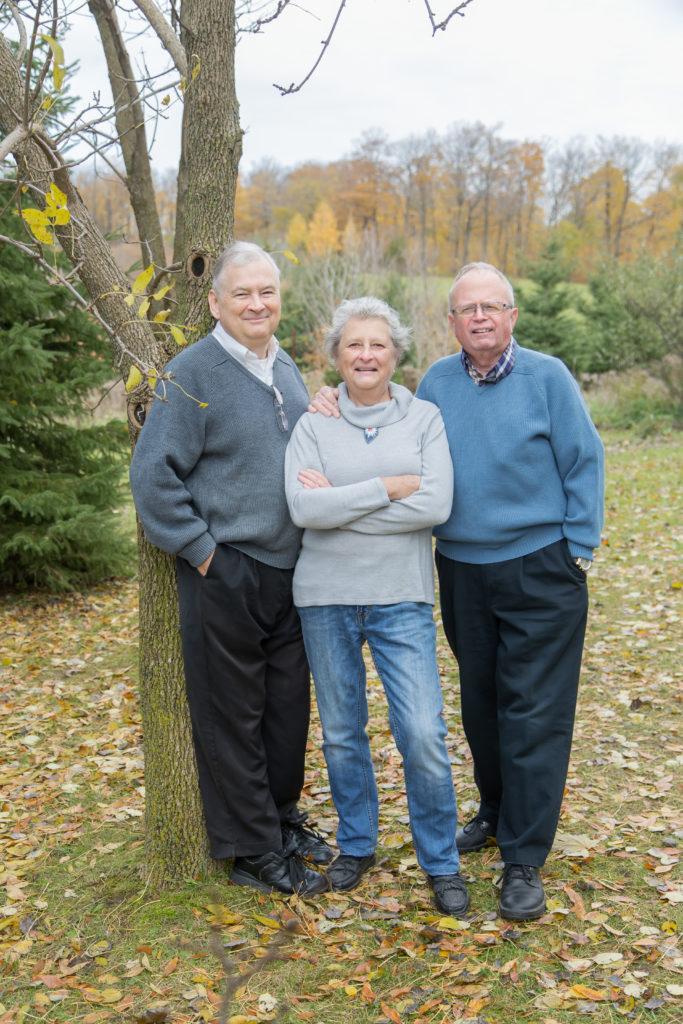
Family creates nature preserve where birders, butterfly hobbyists and others flock to study flora and fauna
By Helen Lammers-Helps
Photography by Tomasz Adamski
“It’s like living in the Magic Kingdom,” Sandy Hill says, referring to the many birds, butterflies and other wildlife she sees regularly on the farm where she lives with her husband, Jamie, and brother, Dave Westfall.
In the past few years, the farm, which they call SpruceHaven, has become a source of wonder and study for local naturalists, university students and families. More than 120 species of birds, dozens of species of butterflies, hundreds of different moths, salamanders and other wildlife have been identified.
Although Hill has lived at this St. Agatha-area property since the turn of the century, she says they only realized its natural significance recently. “It’s only in the last three to four years that it’s been coming to light and we’re just like ‘Wow!’ ”
It started when a visiting family member observed barn swallows flying over the pond and noted that these birds are a threatened species.
This prompted Westfall to contact David Gascoigne, then president of Waterloo Region Nature, a club for nature enthusiasts. An expert birder, Gascoigne was excited by the opportunity to study the barn swallow colony nesting in the century-old barn at SpruceHaven. These birds, which feed off flying insects, are in serious trouble, with populations in significant decline since the mid-1980s.
“Everything starts with knowledge,” says Gascoigne, whose research is done in collaboration with Environment Canada. “The more we understand, the more we can do something.”
And the barn swallows were just the start. His connections have led to a network of birders, butterfly hobbyists, university students and others studying the flora and fauna at SpruceHaven. Waterloo Region Nature also regularly holds educational events for families at the farm.
Hill says she has learned so much since they made their farm accessible for scientific study and educational events. “It’s been a great experience for the entire family. We wouldn’t have learned any of this if we hadn’t shared.”
Gascoigne visits the barn three times a week while the barn swallows are nesting. In 2018, 25 of the 87 nests were occupied and some had two broods.
He says the SpruceHaven colony has likely been in existence since the barn was built more than 100 years ago. Each year in late summer, the barn swallows migrate south and then return to the same mud nests the following spring to start the cycle again.
A neighbouring horse farm owned by Mike and Beth Voll – the Blaze Farm in Wilmot Township – has been added to the barn swallow study to compare how the birds fare with and without the presence of livestock. As many fledglings as possible are banded at both locations, Gascoigne says.
“Sometimes there is simply not enough clearance between the top of the nest and the ceiling to enable us to safely extract the nestlings so we leave them alone,” he says. “This is rare, however, and in excess of 95 per cent of the young birds are banded.”
An attempt to band most of the adults is planned this year, he says.
Young swallows are banded at around 10 days old, Gascoigne says. The birds are extracted from the nest, weighed, the parasite load in the nest is checked, and a unique identifying band is attached to their leg. Birds at SpruceHaven are banded on the right leg, while the birds at the horse farm are banded on the left leg for quick visual identification. The number on each band is unique and will be carried by the bird for the rest of its life.
To learn more about where the birds go when they fly south, a Motus Wildlife Tracking System antenna has been installed at SpruceHaven.
Radio tags are attached to adult birds or recently fledged birds. They are caught in a mist net and if they are not already banded, they are banded before attaching the tracker. “We weigh the birds, measure the wing chord, and inner and outer tail feathers,” Gascoigne says. “The lightweight radio tracker is then attached to the bird by means of a harness that passes under the wings. The bird is not impeded by wearing the harness.”
One winter, signals from three of the birds were picked up in Florida and one in Panama. “That was pretty exciting,” says Westfall. “It’s one thing to see it on a map, but it’s an entirely different thing when it’s one of ‘our birds’ that we’ve seen being tagged.”
Gascoigne blogs about his work at travelswithbirds.blogspot.com. But he is quick to credit Westfall, the Hills and the Volls. “I am eternally grateful to them for the opportunity to monitor and track this colony.”
Gascoigne co-ordinates various other studies and educational activities. As he notes: “There’s a lot going on at SpruceHaven.”
So far, programs have identified 24 species of butterflies and 250 species of moth. Undergraduate students from the Ecology Lab at the University of Waterloo are monitoring salamanders in the woodlot and submitting the data to the Herpetological Atlas of Ontario. “Salamanders are good indicators of the health of the environment,” Gascoigne says.
University graduate students are studying the phenomenon of satellite tracking organisms, and the degree of success it has in revealing patterns of migration and foraging, Gascoigne says.
Gascoigne emphasizes the value of hands-on experience for children and students. “When you put a little baby bird in their hands that was hatched nine days ago, and you tell them, ‘Six weeks from now it’s going to fly all the way to South America. How do you think it knows how to get there? It doesn’t have a map or GPS. And next year it’s going to fly back to this barn.’ It makes it come alive for them so much more than a dry textbook,” he says.
“SpruceHaven is living proof of what can be accomplished with a little bit of stewardship on an ordinary farm, with a willing landowner and keen inquiring minds to discover what’s there.”

Sandy Hill is flanked by her husband, Jamie, and brother, Dave Westfall.
Hill says her family feels fortunate to have tapped into the network of specialists. “It has been a fascinating journey. One thing leads to another.”
All of the visitors have been respectful and often help out by pulling invasive weeds or bringing bird nesting boxes.
While there isn’t anything particularly special about the property, the work that Westfall and Hill and their families have done through the years has helped to create a diversity of plants that supports a broad diversity of birds and wildlife.
Westfall remembers being enchanted by the barn swallows cruising for insects over the pond when his parents, Ralph and Hazel, toured the rundown farm back in 1977. After purchasing the farm that year, they were disappointed that the pond was actually only a shallow runoff pond prone to algae.
One of their first projects was to excavate the pond and plant it with shrubs and trees. Cattails, dogwoods and other native vegetation moved in on its own.
These days bird visitors include Canada geese; ducks such as the wood, bufflehead and mergansers; great blue and green herons. Bluebirds, tree swallows, house wrens and black cap chickadees breed in nesting boxes.
“It’s exciting to see who shows up,” says Westfall.
The elder Westfall generation also added a variety of shrubs and flowers around the existing spruce tree shelterbelt planted in the 1920s – the inspiration for the SpruceHaven name.
When Ralph and Hazel moved to a retirement home, Dave, Sandy and Jamie took over and planted more trees and native plants.
“It’s been incremental,” says Hill, who likes to spend time outside puttering around the property.
In 2007, almost 3,200 trees and shrubs were planted with the help of the Grand River Conservation Authority.
The owners have continued purchasing trees from the conservation authority, a few hundred at a time, and planted them in key areas. A corridor of trees now connects the plantings around the house with the mature woodlot at the back of the farm.
A pollinator-friendly wildflower mixture, including wild bergamot, black-eyed susans, evening primrose, and hairy beardtongue, was seeded among the young trees. “The first year not much came, the next year a few things came and the third year it was looking pretty darn good,” Hill says.
“We wanted a diversity of plants in case another disease or pest like Dutch elm disease came through,” explains Westfall. Priority was given to native trees and shrubs, but he admits they are not purists. “Not all of them are native, but we tried to stay within the same families,” he says.
Now that he’s retired from Erb and Erb Insurance Brokers, Westfall says he enjoys researching what to plant.
The property has a lot of different habitats, including the pond, a swale, a mature woodlot and the new plantings. In future, Westfall and Hill hope to convert some of the farmland to grassland to further diversify the habitat. This would encourage a whole new set of grassland birds such as eastern meadowlark, bobolink, upland sandpiper, grasshopper sparrow and vesper sparrow.
Westfall points out you don’t have to have a lot of property to have a positive impact. “There are a lot of little things people can do on their property that are supportive of nature, to increase diversity and make your property more resilient to infestations,” he says.
Hill agrees. “When we found out the monarchs were in trouble, we spread some seed around and now we have patches of milkweed. Little things like that. . . . It costs you nothing and it helps the monarchs,” she says.
“It makes you feel like you’re making a small difference in a positive way. And you learn as you go.”

SpruceHaven’s neighbour, Jeff Grant, wins award for efforts to save butterflies
Next door to SpruceHaven lives a remarkable teen who has been recognized for his work advocating for native butterflies.
Jeff Grant, 15, was awarded a 2018 Watershed Award by the Grand River Conservation Authority for his efforts to educate the public about native butterflies, raise and release butterflies, and create butterfly habitat.
“Butterflies are in trouble and they need our help,” Grant says. Populations have been declining due to habitat loss and pesticide use.
Lisa Stocco, communications manager for the conservation authority, says the selection committee for the award was impressed by his love of butterflies, especially monarchs. “Jeff’s nomination demonstrated some of the great work youth are doing to support the environment in the watershed.”
Last year Grant released 400 monarch butterflies that he had raised himself. The butterflies were tagged so they can be identified if they make it back to the monarch’s overwintering grounds in Mexico.
In a three-by-six-metre greenhouse on his parents’ farm, Grant also raises the rare Baltimore checkerspot, the black swallowtail, the giant swallowtail (Canada’s largest butterfly with a wing span of 10 centimetres), and the pipevine swallowtail. Raising caterpillars inside the greenhouse protects them from predators and improves survival rates.
Grant also grows plants the butterflies need to complete their life cycle inside the greenhouse. Each species of female butterfly has specific host plants where she will lay her eggs; the plants become the food source for the emerging caterpillars. Grant grows milkweeds for the monarchs, white turtle head for the Baltimore checkerspot, parsley and dill for the black swallowtail, rue for the black swallowtail and giant swallowtail, and pearly everlasting for the American lady butterflies.
Some species of butterflies will lay eggs on a number of different plants, but monarchs will only use members of the milkweed family. As a result, milkweed plants are essential for their survival.
Adult butterflies also require nourishment from nectar, a sugar-rich liquid found in both native and non-native plants. Grant grows tall iron weed, boneset, swamp milkweed, black-eyed susans, native monarda and New England aster for their nectar.
By planting swamp milkweed (Asclepias incarnate) and the annual tropical milkweed (Asclepias curassavica) at his parents’ farm and at SpruceHaven, Grant also created additional monarch habitat at both sites.
Grant’s love of butterflies was ignited when his kindergarten teacher brought a butterfly kit into his classroom. He was soon volunteering to look after the butterflies and then began ordering butterfly kits to raise at home. Mentoring from other butterfly enthusiasts has also helped him develop his knowledge, he says.
And over the past three years, he has been passing his knowledge on by teaching children through the Laurel Creek Nature Centre in Waterloo about butterflies, their life cycles, what they eat and how to care for them. He has also taken butterflies to a retirement home to share their story with the elderly residents.
Grant hopes his work will inspire others to grow host and nectar plants for the butterflies in their gardens to help these beautiful but beleaguered insects.
